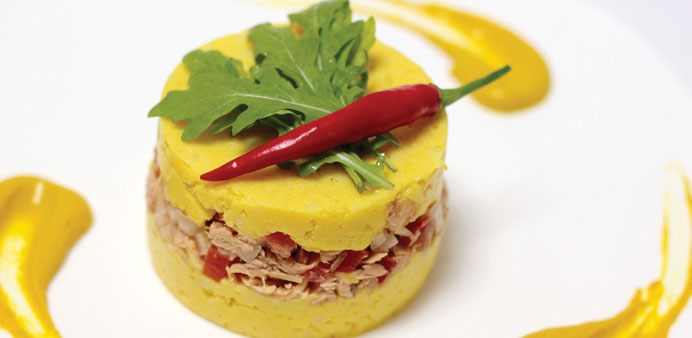- Tarun Kapoor is executive chef at Doha’s Horizon Manor Hotel. Send your feedback to:
[email protected]
Polenta is a cornmeal mash or porridge that is popular in Italy and European countries and hails from Italy, particularly the northern Part of Italy. This was a popular dish among the farmers of the region.
Polenta is mostly made with a coarse yellow cornmeal but can also be made from finely ground yellow or white cornmeal. It is not only easy to cook but there are plenty of options to choose from — you can mix in fresh herbs and cheeses, bake it, set it in a pan and grill it or fry it. Experiment more with this humble dish and you’ll be in love with it.
To cook polenta, simmer it in water or broth, season and serve hot. Traditional polenta can take up to an hour to cook and must be stirred frequently to avoid it getting burnt. Nowadays quick polenta has gained popularity, which can be prepared in microwave even in few minutes, although polenta lovers prefer the slow cooked polenta over the instant version.
Although Polenta is often served as a semi-soft mash topped with a sauce, ragout or cheese, cooked polenta can also be cut into cakes, triangles, squares or any other shape that can be cooked further by baking, grilling, frying or even batter-coated frying.
Today Polenta is relished across the globe and can be easily found in many forms like instant, traditional, gluten-free or white polenta in hypermarkets and grocery stores. Polenta can be classified into coarse ground polenta, fine ground polenta, instant polenta, pre-cooked polenta, white polenta and gluten-free polenta.
There is some similarity and difference between Italian Polenta and American grits. Both are
made from corn but grits are only made from white corn and are treated before grinding. Both differ very marginally from each other in taste and are prepared similarly.
Polenta and health
Polenta is perceived to be a food without much nutrition associated with it; however whole grain corn polenta contains iron, zinc and phosphorous and is a good source of fibre. The carbohydrates in polenta are complex carbohydrates and helps control the glucose levels and also helps in a healthy immune system for our body.
Storage
Dry polenta has a long shelf life and can be stored in air tight containers for yearlong where as fresh polenta has a short life of few days and should be consumed within two days of preparation.
Polenta and Tuna Cake
Serves 4
Ingredients
Instant polenta 500 gm
Water 2 litres
Milk 500 ml
Virgin olive oil 4 tbsp
Tuna fish 150gm
Rocket lettuce Few sprigs
Parmesan cheese ½ cup
Kosher salt To taste
Black pepper To taste
Red bell pepper 1 no
Yellow mustard 1/3 cup
Method
Bring the water, milk and salt and pepper to boil and gradually add polenta, whisk continuously to avoid lumps.
Once the polenta boils, simmer the heat and continue to cook until polenta is smooth and creamy.
Add more moisture if it starts to stick to the bottom or if the water evaporates before polenta is cooked.
Remove from flame and keep aside for a while.
Grease a tray with oil and spread the polenta flat on the tray, refrigerate for 2 hours.
In a separate pan heat oil and sauce chopped bell peppers with tuna fish, season and keep aside.
Once the polenta is cold and set, using a 3” cookie cutter to cut out the polenta and place on a plate.
Pour the prepared tuna mixture on top and grate parmesan cheese on it.
Place another polenta cake on top and finish with some rocket lettuce on top and yellow mustard on side.
You can also grill the prepared polenta rounds on a hot plate for brown crust outside and soft inside.
Note: While cooking polenta one of the most important considerations is the ratio of polenta to water the ideal ratio is 1:5 for polenta and moisture. Also keep on stirring the polenta while cooking as not stirring will result in a skin formation on top and can result in lumps inside the polenta.

Polenta and Tuna Cake
